Baseball Billiards Rules
Baseball pocket billiards (aka "baseball pool", "baseball billiards" or simply "baseball" in context) is a pocket billiards game designed with phraseology and design aspects of the game of baseball. For example, the 9 ball is known as the "pitcher", the table's foot spot where balls are racked is known as "home plate", and each team or player is afforded "nine innings" to score as many "runs" as possible.
With the rules below, you'll learn how to play baseball pocket billiards.
Unless conflicting with the rules of baseball billiards as outlined below, the [General Rules of Pocket Billiards]( "General Billiard Rules") apply to baseball pocket billiards.
Baseball Billiards
Baseball Billiards is played with a 22-ball set consisting of 21 object balls, numbered from 1-21, and a white cue ball. It requires the use of a special 21-ball over-sized rack triangle.
The general idea is that each player gets 9 innings to score as many points as possible. Players score points in each inning by pocketing as many balls as possible before missing or scratching.
NOTE: There are kits available from Classic Billiards in Fallston, MD.
- Aramith billiard balls #16 - #21, a 21-ball triangle ("oversized rack"), and a pamphlet with the rules for baseball billiards, for around $140 USD.
- Same as above, but with all 21 balls, for around $250 USD.
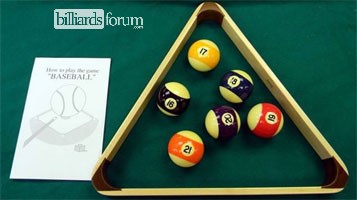
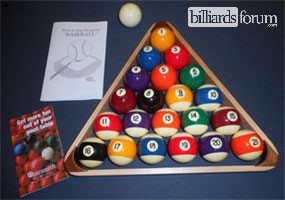
Older baseball billiards ball sets pop up from time to time on eBay as well.
Racking the Balls
The object balls are racked at the foot spot in a 21-ball triangle.
- The 1-ball is placed on the foot spot, which is called "home plate."
- The 2-ball and 3-ball, respectively, are placed at the left and right corners of the triangle (from the perspective of looking toward the apex of the rack).
- The 9-ball, called the "pitcher," is placed in near the center of the rack.
Break Shot
Players lag (or lot) to determine the order of play.
The starting player has the cue ball in hand within the kitchen, and is credited with all balls scored on the break shot.
Continuing Play
After the break, the player continues, but must call all shots, including the ball and the pocket.
Each player has nine shots, or "innings" at the table, which are played in succession, meaning the player continues at the table until completing all nine innings.
An inning lasts until the player misses or commits a fool, which results in loss of turn.
Incoming players have balls racked and proceed as above, playing nine innings.
The game ends when all players have completed nine innings of play.
The winner is the player with the most runs after all have played.
Scoring
Players are credited points for all balls legally pocketed. Each ball counts for its numerical face value.
The number of runs scored corresponds to the number of balls pocketed by the player.
If a player scores the 12-ball and 13-ball in one inning, the player is credited for 25 runs in that inning.
Scores are posted by innings on a score sheet.
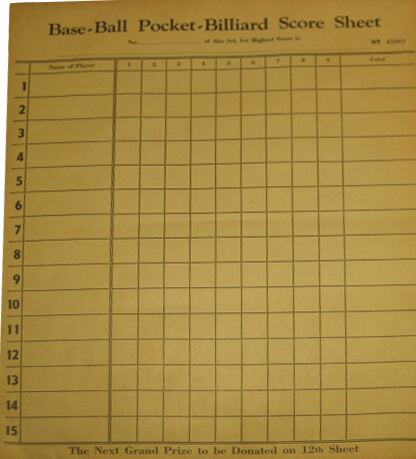
Spotting Balls
If a player pockets a ball and makes a scratch, the object ball is spotted on the "home plate" (foot spot). If home plate is occupied, balls are spotted according to general rules for spotting balls in pocket billiards.
Scratch
If a player scratches, the inning is over and a "0" (zero) is placed in that inning on the score sheet. He then plays the next inning.
If the shooter scratches and no object ball is pocketed, it is still regarded as a scoreless inning.
Scratches are penalized by forfeit of all balls pocketed on the foul stroke, plus the last called ball legally pocketed. If the player has no balls to his credit, he spots next called ball scored.
Calling Shots
If a player makes a called ball as designated, all other balls pocketed on the same stroke accrue to his credit.
If failing to pocket the called ball, and other balls drop in the pockets, the pocketed balls are spotted. A scoreless inning is recorded and the player continues on to the next inning. If it is his last inning, play passes to the next player.
Nine Innings
Any number of players may play baseball pocket billiards, but before the game is complete, all players must have nine innings at the table.
If a player runs all the balls before completing nine innings of play, the balls are re-racked and player continues until completing nine innings, and then the total score is posted.
Penalty for Fouls
When a foul is committed, the penalty is as follows:
- Loss of turn,
- no score for the ball(s) pocketed on the fouled stroke, as well as
- no score for the immediately preceding pocketed ball during any inning. This means that if a player did not legally pocket a ball on the stroke preceding the foul, the last ball pocketed in that player's last scoring inning is spotted and subtracted from that prior inning's score. If the player has not yet made any balls at the time of the foul, the first subsequent ball pocketed is spotted at the inning's conclusion and does not count toward the player's score.
All balls pocketed on a fouled stroke are spotted to home plate.
Baseball Billiards Rules
If you have any questions about Baseball Billiards Rules, please post them in the pool rules forum.
Baseball Billiards Rules History
The origins of Baseball Billiards in this form is not known.
There are several references dating back to the early 1900s, most notably a mention in a Brunswick Balke Collender pamphlet where it was described as "the most fascinating game of the twentieth century".
Baseball Pool Ball Sets in 1928 Brunswick Balke Collender Catalog
A 1928 Brunswick Balke Collender billiard supplies catalog has a half-page dedicated to the "baseball set" (22 balls, larger triangle, and score sheets) and individual baseball pocket billiard accessories.
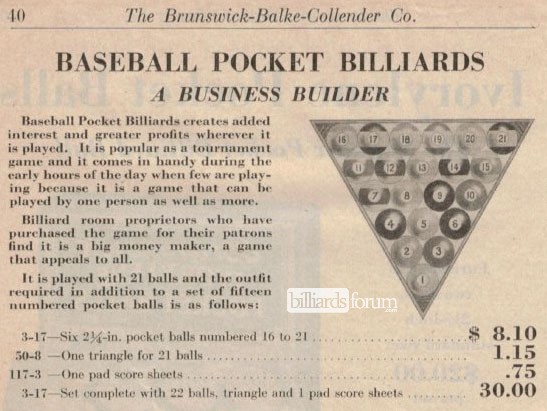
Baseball Pocket Billiards
A Business Builder
Baseball Pocket Billiards creates added interest and greater profits wherever it is played. It is popular as a tournament game and it comes in handy during the early hours of the day when few are playing because it is a game that can be played by one person as well as more.
Billiard room proprietors who have purchased the game for their patrons find it is a big money maker, a game that appeals to all.
It is played with 21 balls and the outfit required in addition to a set of fifteen numbered pocket balls is as follows:
- 3-17 - Six 2 1/4-in pocket balls numbered 16 to 21 - $8.10
- 50-8 - One triangle for 21 balls - $1.15
- 117-3 - One pad score sheets - $0.75
- 3-17 - Set complete with 22 balls, triangle, and 1 pad score sheets - $30.00
Baseball Pool Ball Sets in 1950 Brunswick Billiards Catalog
A 1950 Brunswick catalog again features baseball billiards, this time, a set of balls #16 to #21 which you add to a traditional set of pocket billiard balls to make a baseball set. On the first page of this "Fall-Winter 1950" catalog, Brunswick refers to the set as "one of the most fascinating versions of pocket billiards ever devised".
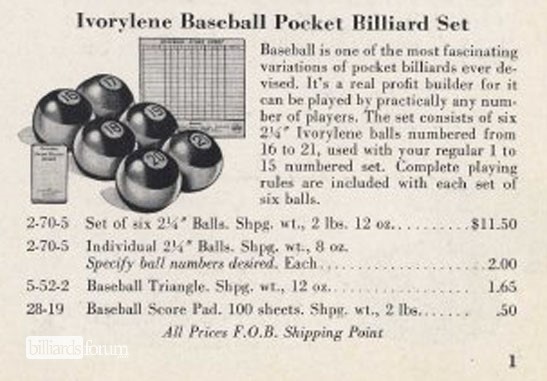
Ivorylene Baseball Pocket Billiard Set
Baseball is one of the most fascinating variations of pocket billiards ever devised. It's a real profit builder for it can be played by practically any number of players. The set consists of six 2 1/4 Ivorylene balls numbered from 16 to 21, used with your regular 1 to 15 numbered set. Complete playing rules are included with each set of six balls.
- 2-70-5 - Set of six 2 1/4 Balls. Shpg. wt., 2 lbs, 12 oz - $11.50
- 2-70-5 - Individual 2 1/4 Balls. Shpg. wt., 8 oz (specify ball numbers desired) - Each - $2.00
- 5-52-2 - Baseball Triangle. Shpg. wt., 12 oz - $1.65
- 2-70-5 - Baseball Score Pad. 100 sheets. Shpg. wt., 2 lbs - $0.50
The official Baseball Billiards Rules are predominently observed in North America.
The official governing body for Baseball Billiards Rules is the Billiard Congress of America.
How to Play Baseball Billiards
Questions about Baseball Billiards Rules:
- Title: Baseball Billiards Rules
- Author: billiardsforum (Billiards Forum)
- Published: 3/11/2019 4:48:17 PM
- Last Updated: 3/12/2019 4:30:03 AM
- Last Updated By: billiardsforum
Baseball Billiards Rules
The Baseball Billiards Rules article belongs to the Pocket Billiards Rules category. Pocket billiards is a class of cue sport game commonly referred to as pool.
Baseball Billiards Rules Comments
user1638722956 from Lewisville, TX on 7/5/2022 9:21:23 PM
I noticed the score sheet above in the Baseball Billiards rules.
I have some original Brunswick Balke Collender Baseball pool score sheets. They are similar to yours, but they are more detailed and have the BBC info on them. They even have serial numbers on each sheet for some reason.
If you actually own the score sheet shown, would you be willing to trade one of your score sheets for one of mine? Just curious.
 billiardsforum from Halifax, NS on 8/22/2022 1:43:56 PM
billiardsforum from Halifax, NS on 8/22/2022 1:43:56 PM@user1638722956 - It's great that you have some original Brunswick Balke-Collender baseball score sheets.
Unfortunately, I do not have an original copy of the baseball billiards score sheet posted above.
On that note, if you want to share a clear, well-lit photo of the Brunswick score sheet, I'll be happy to post it here.
Reply and share your comments below:
